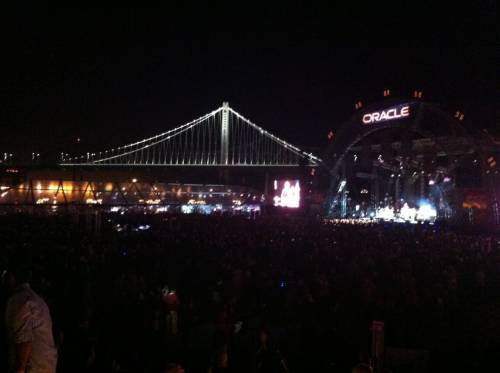
My final day at Oracle OpenWorld 2013, less sessions and less people but still a big day after almost one week in San Francisco. In this blog I’ll focus on the private cloud with databases as service and the fundamentals about replication. To conclude on Oracle OpenWorld, I would say that there are three big news – more on these at the end of this posting.
On Thursday, there are less people in the sessions and there is a reason: on Wednesday, everyone was invited on Treasure Island for 2 concerts. And with famous bands: Maroon 5 and the Black Keys.
Each day showed that OpenWorld is a really big event, but let’s start with the interesting concept of private cloud.
Database as a Service
In a “hands on lab” session with Mark Scardina, Director of Quality of Service Management at Oracle, we had 2.5 hours to test Real Application Cluster with 2 features to insure service distribution:
- QoS management Policy
- Policy-managed Database
Those features are not completely new because those have been introduced in 11.2. But if we combine services and consolidation with the multitenant option, we have a kind of private cloud with databases distributed to the applications as services.
The goal was to show how to create a QoS policy to ensure the priorities between the services and meet the SLAs. With a policy-managed database and a defined QoS management policy, it’s easy to give some service a higher priority, then all services are monitored and in a Dashboard, Enterprise Manager gives us advices to keep the performance defined in QoS policy.
Speakers told also a little about Application Continuity. That 12c feature added to the others, application should always be running whatever happens on a specific node if there is still another node to handle the service.
Replication fundamentals
The speaker was Arjen Visser, founder of Dbvisit software. There are two replication concepts: physical and logical and he focused on the logical replication principles. He was explaining how products like GoldenGate or Dbvisit Replicate work.
Unlike physical replication where all blocks are identical, logical replication consists in having the same data but on a totally independent database. It’s quite often used for reporting purposes whereas physical replication is used for Disaster and Recovery.
There are 3 kew concepts to enable logical replication:
- Conversion: DML statements have to be catched on source database and converted into row-by-row operations. It’s because the products don’t have a way to get SQL statements but only the changes from in redo logs.
- Identification: Following the first principle, each operation should affect one row so each row in a table has to be identified uniquely.
- Conflict: If an operation changes 0 row or more than 1 rows, the synchronization between source and target is compromised. The replication product has to have a mechanism to detect, handle the conflits
Conclusion
I noticed that Oracle keeps the strategy of engineered systems, they can provide the full stack from the hardware to the software with machines tuned to run Oracle databases. Several appliances were available on demo during that week. Using such solutions also allows a full management in Enterprise Manager 12c that would be the only place to manage the entire infrastructure.
It seems we are in a cycle, from mainframe to servers and we may be in a way to go again in kind of mainframe where the machines including the processors (software on chips) are designed to run certified software.
But finally, there are 3 big news in that OpenWorld:
- Oracle Database and Java available in Windows Azure
- Oracle Database and Java available in Oracle’s public cloud
- New In-Memory option. I really hope that I’ll be able to test it soon.

![Thumbnail [60x60]](https://www.dbi-services.com/blog/wp-content/uploads/2022/11/NIJ-min-scaled.jpg)
![Thumbnail [90x90]](https://www.dbi-services.com/blog/wp-content/uploads/2022/08/STH_web-min-scaled.jpg)